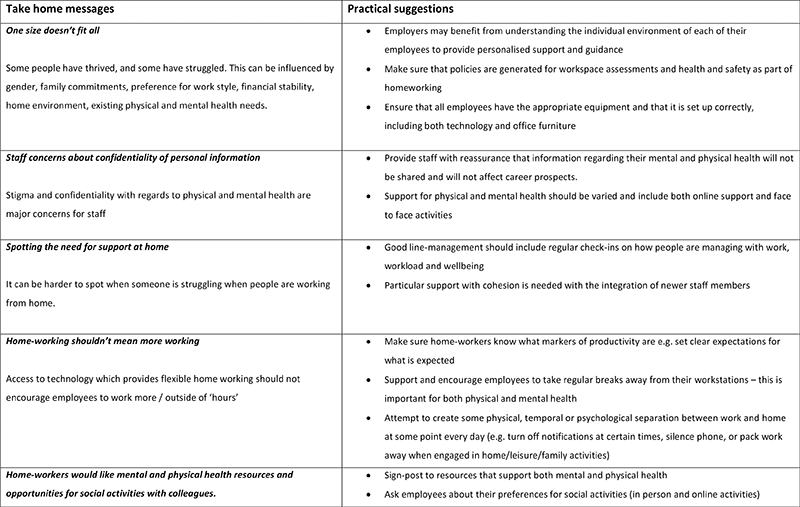Working Well from Home

Homeworking is likely to continue for many workers in East Sussex, even as we transition out of the pandemic. However, we do not yet know about the long-term impact of homeworking and we do not have long-term plans about how best to support people to effectively work at home. 86.4% of businesses in East Sussex have fewer than 10 employees. Small businesses are less likely to have in-house human resources support, therefore it is crucial to provide the support they need to help their employees to work well at home.
The East Sussex ‘Working Well From Home’ research project was a collaboration between the University of Sussex, Team East Sussex, East Sussex County Council, Locate East Sussex and local business consultants. The findings of this research project were combined to produce best practice guidelines for employers when navigating home-working procedures with their employees.
Impact on the workforce of working at home during a pandemic
Findings of the East Sussex Working Well from Home survey
A survey was carried out in May 2021 with employers, employees, and self employed workers living and/or working in East Sussex. This included questions about their homeworking experiences and support needs in relation to a number of domains, including mental and physical health, technology, and working relationships.
263 participant survey responses were analysed, and 5 in depth interviews were conducted. Responses are summarised below and reflect the range of responses which were given, as such there are contradictions in people’s experiences of positive vs negative impacts that working from home had.
Productivity
Positive Impacts:
- Increased concentration and fewer distractions
- Increased flexibility
- Less time spent commuting
- Better use of technology
- Increased efficiency
Negative Impacts:
- Lack of engagement and barriers to communication
- Stifled innovation
- Increased distractions
- Poor motivation
- Zoom fatigue
- Technological limitations


Mental Health
Positive Impacts:
- More flexible workday
- Less commuting stress
- More time at home
- More pleasant work environment
- More relaxed mornings
- Physical health improving mental health
- Less stressed about work
- Improved confidence
Negative Impacts:
- Uncertainty with learning new job roles
- Social isolation and loneliness
- Difficulty maintaining work/life balance
- Struggles with work/family balance
- Decreased physical activity
70% of respondents reported that their organisation offered mental health support that was accessible at home.
Suggested Provision:
- Access to professional support (e.g. CBT and counselling)
- Access to information and resources (e.g. self-care resources, general info and online assessments)
- Access to supportive activities (e.g. social opportunities, mindfulness, meditation)
Barriers to Accessing Support:
- Concerns about privacy and confidentiality (e.g. colleagues or managers may find out, access to support may be recorded on personnel records)
- Stigma (e.g. fear of judgement and that accessing support would affect future opportunities)

Physical Health
70% of respondents reported that their organisation offered physical health support that was accessible at home.
Suggested Provision:
- Access to activities (e.g. exercise classes, physical activity challenges, walking groups/meetings, workplace sport teams)
- Discounted gym/leisure facilities
- Information and resources (e.g. food guidance, occupation health, tips for staying active)
Barriers to Accessing Support:
- Lack of time
- Unsuitable scheduling
- Psychological barriers such as motivation and confidence
Health and Safety
46% of respondents reported that their organisation had adapted workplace health and safety procedures to the homeworking context.
Suggested Provision:
- Provision of health and safety assessments (e.g. virtual workstation assessments or home visits, support to address issues raised in assessments)
- Provision of suitable workplace equipment (e.g. suitable desks, chairs and IT equipment)


Technology
80% of respondents reported that they had all the necessary technology to conduct their work from home. The following responses were given in regards to challenges related to technology:
- Lack of equipment
- Poor internet connection
- Inadequate equipment
- Compatibility of work environment
- Lack of space
- GDPR
- Training with technology
- Security

Working Well From Home – Best Practice Toolkit of Recommendations for Employers
Most survey respondents reported that they either wanted to continue homeworking fulltime or that they would want a flexible hybrid model of working. As such, it is important that organisations consider the long-term model of homeworking which considers the practicalities, such as office equipment and health and safety, as well as physical and mental wellbeing. This research has identified key areas of practice that can be adopted by organisations to help provide this support. These suggestions are outlined in the ‘Toolkit’ below:
It is important to note the limitations of the survey and interviews in reflecting a diverse range of opinions, for example, the participants were majority female, white British, and employees rather than employers. However, this is somewhat alleviated by the examination of the research literature to fill in the gaps and back up findings from the research.





